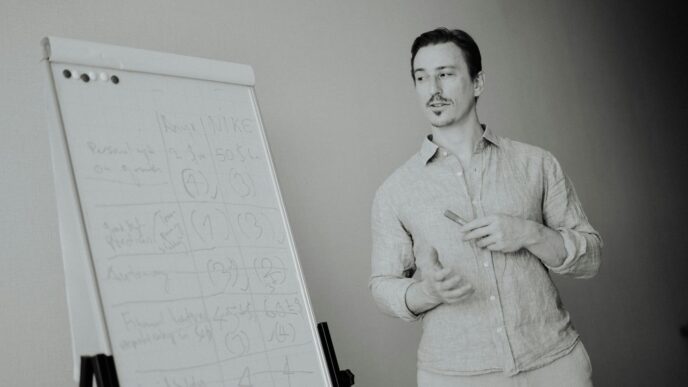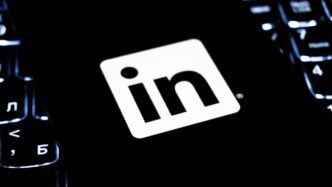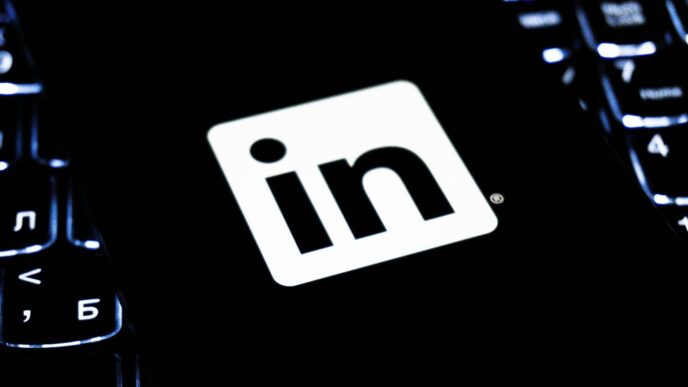Your LinkedIn headline is like your digital handshake. It’s the first thing people see when they find your profile, and it really matters for getting noticed. Making sure your headline is clear and shows what you do can make a big difference in attracting the right attention, whether you’re looking for a new job or trying to connect with clients. We’ll go over how to make your good LinkedIn headlines work for you.
Key Takeaways
- Your LinkedIn headline is your profile’s first impression and a major factor in search results, influencing whether people view your profile.
- A strong headline clearly states your professional identity, highlights your main skills, and communicates what makes you different.
- Job seekers should use keywords from job descriptions and show their value with achievements to improve search visibility.
- Entrepreneurs and thought leaders should focus on selling their services and value proposition, using strong verbs and calls to action.
- Make your headline stand out by including achievements, soft skills, or career goals, but avoid too many buzzwords and emojis for better readability.
Developing Headlines for Entrepreneurs and Thought Leaders
For entrepreneurs and thought leaders, your LinkedIn headline isn’t just a title; it’s your digital storefront. It needs to grab attention fast and tell people exactly what you do and why they should care. Think of it as your elevator pitch, but in text form and with a character limit. You’re not just looking for a job here; you’re looking to attract clients, partners, or build your brand. So, how do you make it work for you?
Selling Your Services and Value Proposition
This is where you get to the heart of what you offer. Instead of just listing your job title, explain the problem you solve or the benefit you provide. For instance, instead of "Marketing Consultant," try "Helping SaaS companies double their lead generation through targeted content strategies." It’s about showing results, not just responsibilities. Clearly stating the outcome for your clients is key. Think about what makes you different. Are you faster, more innovative, or do you have a unique approach?
Engaging Your Audience with Strong Verbs
Words matter. Using active verbs makes your headline more dynamic and compelling. Instead of "Responsible for managing projects," consider "Driving project success from concept to completion." Verbs like "building," "creating," "transforming," or "accelerating" can make a big difference. They show you’re a doer, not just someone who occupies a role. It’s about conveying action and impact.
Including Calls-to-Action for Engagement
Don’t be afraid to guide people on what to do next. A subtle call-to-action (CTA) can encourage interaction. You could add something like "DM me for a free consultation" or "Follow for daily insights on [your industry]." This makes it easy for interested people to connect or engage with your content. It turns a passive profile view into a potential lead or follower. For more ideas on how to craft these attention-grabbing statements, check out these examples of effective LinkedIn headlines.
Refining Your LinkedIn Headline

So, you’ve got a decent headline, but it could be better, right? That’s where refining comes in. It’s not just about slapping on a title; it’s about making sure it actually works for you. Think of it like tuning up a car – you want it running smoothly and looking sharp.
Using Sentence Breaks for Readability
Nobody wants to read a giant wall of text, especially on a platform like LinkedIn. Breaking up your headline makes it easier to scan and digest. Using pipes (|) or even just strategic spacing can make a big difference. It helps people quickly see what you’re about without having to squint. A clear, easy-to-read headline is more likely to grab attention.
Limiting Buzzwords and Emojis
We all see those headlines packed with every industry buzzword imaginable, or worse, a string of emojis. While a few well-placed keywords are good, too many can make your headline sound generic and frankly, a bit much. Emojis can sometimes come across as unprofessional, depending on your field. Stick to clear, direct language that accurately reflects your skills and what you do. You want to sound professional, not like you’re trying too hard.
Tailoring Headlines to Specific Goals
Your headline shouldn’t be a one-size-fits-all thing. Are you looking for a new job? Trying to attract clients? Want to be seen as a thought leader? Your headline should reflect that. For instance, if you’re job hunting, you might want to include keywords that recruiters are searching for. If you’re an entrepreneur, you might focus more on your unique selling proposition. It’s about making sure your headline is working towards what you want to achieve on the platform. You can check out advice for crafting effective headlines to get a better idea of how to adjust yours.
Putting It All Together
So, we’ve gone over why your LinkedIn headline really matters and how to make yours work harder for you. It’s not just about listing your job title; it’s about telling a quick story that makes people want to know more. Remember to keep it clear, use keywords people actually search for, and maybe add a touch of what makes you unique. Don’t be afraid to look at what others are doing for ideas, but always make it your own. A good headline can open doors, so take the time to get it right. Your next opportunity might just be a scroll away.
Frequently Asked Questions
Why is my LinkedIn headline so important?
Think of your headline as your professional billboard. It’s the very first thing people see when they find your profile, like a quick introduction. A good headline grabs attention and makes people want to learn more about you, which can lead to new chances for jobs or meeting new people.
How does my headline help me get found on LinkedIn?
Your headline helps people find you on LinkedIn. When someone searches for skills or jobs, LinkedIn’s search system looks at headlines to decide which profiles to show. Using the right words in your headline makes it easier for the right people to discover you.
What makes a LinkedIn headline effective?
To make a great headline, clearly state what you do and what you’re good at. Mention your main skills and what makes you special. Think about what makes you different from others and what value you bring to a company or client.
What should job seekers put in their headlines?
For job seekers, include words that hiring managers search for, like specific job titles and skills. Show what you’ve achieved and the value you can bring. Avoid common mistakes like using too many fancy words or too many emojis.
How can entrepreneurs and leaders make their headlines stand out?
Entrepreneurs and leaders should focus on what they offer and the benefits for their customers. Use strong words that encourage people to take action, like visiting a website or learning more. Sometimes, adding a question can get people talking.
What are some tips for making my headline better?
Try to make your headline easy to read by using breaks like ‘|’ or ‘-‘. Don’t use too many buzzwords or symbols. Keep it simple and clear. If you can, add a key achievement or something you’re passionate about to make it more personal and memorable.














